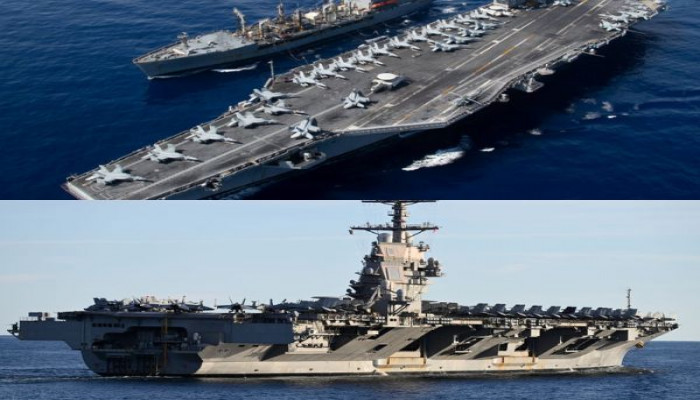US intensifies military buildup in Caribbean, deploys Gerald Ford aircraft carrier group
- In Reports
- 07:20 PM, Oct 25, 2025
- Myind Staff
President Donald Trump’s administration intensified a US military buildup in the Caribbean on Friday by announcing the deployment of the Gerald Ford aircraft carrier group to Latin America, marking a display of power far stronger than any previous counter-narcotics mission and Washington’s most forceful move in the region so far.
This deployment, which adds to the eight warships, one nuclear submarine, and F-35 aircraft already stationed there, represents a sharp escalation as tensions rise with Venezuela, whose government Washington has long accused of supporting drug traffickers and eroding democracy.
“The enhanced U.S. force presence in the USSOUTHCOM AOR will bolster U.S. capacity to detect, monitor, and disrupt illicit actors and activities that compromise the safety and prosperity of the United States homeland and our security in the Western Hemisphere,” Pentagon spokesperson Sean Parnell posted on X.
He did not say when the carrier would arrive in the region, but a few days earlier, it was sailing through the Strait of Gibraltar and was stationed in Europe.
The Gerald Ford, commissioned in 2017, is the newest and largest aircraft carrier in the world, carrying over 5,000 sailors on board.
Since early September, the US military has conducted ten strikes against suspected drug boats, mostly in the Caribbean, killing around forty people. The Pentagon has shared limited information but said that some of those killed were Venezuelan.
Venezuelan President Nicolas Maduro has repeatedly claimed that the US is trying to remove him from power.
On Thursday, Maduro warned that if the US ever intervened in Venezuela, “the working class would rise and a general insurrectional strike would be declared in the streets until power is regained,” adding that “millions of men and women with rifles would march across the country.”
In August, Washington doubled its reward for information leading to Maduro’s arrest to $50 million, accusing him of being linked to drug trafficking and criminal networks, which Maduro denies.
Tensions have also risen between the US and Colombia in recent days, after Trump accused Colombian President Gustavo Petro of being an “illegal drug leader” and a “bad guy,” comments that Petro’s government called offensive.
“These forces will enhance and augment existing capabilities to disrupt narcotics trafficking and degrade and dismantle (transnational criminal organizations),” Parnell said.
Trump has also authorised the Central Intelligence Agency to carry out covert operations in Venezuela.
Only hours after US Defence Secretary Pete Hegseth confirmed the carrier deployment, the Trump administration announced sanctions against President Petro, citing alleged drug-related activities.
Trump said his Republican administration would brief Congress about operations against drug cartels, adding that although a declaration of war was not needed, ground operations against cartels could follow soon.
On Friday, Hegseth said that the latest US strike on a suspected drug vessel killed six alleged “narco-terrorists” in the Caribbean.
These operations have sparked concern among some legal experts and Democratic lawmakers, who have questioned whether such actions comply with the laws of war. Meanwhile, several Republican lawmakers welcomed the decision.
“President Trump is not messing around when it comes to protecting the U.S. and our Western Hemisphere neighbourhood,” US Representative Rick Crawford of Arkansas posted on X.
Last week, Reuters reported that two suspected drug traffickers survived a US military strike in the Caribbean. They were rescued and taken aboard a US Navy ship before being sent back to their home countries, Colombia and Ecuador.
With only eleven aircraft carriers in its fleet, the US treats these assets as highly valuable, and their deployment schedules are usually planned long in advance.
Last year, the USS George Washington was sent to South America, but that mission had been planned earlier as part of an exercise.
The Gerald Ford, powered by a nuclear reactor, can carry more than seventy-five aircraft, including F-18 Super Hornet jets and E-2 Hawkeye planes that serve as early warning systems.
It is also equipped with advanced missiles such as the Evolved Sea Sparrow Missile, a medium-range weapon designed to counter drones and enemy aircraft.
The ship has modern radar systems that help with navigation and air traffic control.
The carrier group includes support ships such as the Ticonderoga-class guided missile cruiser Normandy and the Arleigh Burke-class destroyers Thomas Hudner, Ramage, Carney, and Roosevelt, which are equipped for air defence, surface warfare, and anti-submarine missions.







Comments